Drunk driving claims approximately 34 lives every day across the U.S. These deaths are preventable, but they continue to occur due to impaired judgment and the assumption that driving after just one drink is safe.
In our new report, we highlight the latest drunk driving statistics, including evidence on the impact of reckless behavior behind the wheel. Let’s get into it.
Drunk Driving Statistics 2025 [Infographic]

Traffic school can help you keep a clean driving record, prevent insurance increases, and more!
Drunk Driving Statistics by State
According to a 2025 Forbes report, the states with the highest number of alcohol-related traffic fatalities are:
| State | % of traffic fatalities caused by drunk drivers | Drunk drivers in fatal crashes per 100,000 licensed drivers | People killed in drunk-driving crashes per 100,000 residents |
|---|---|---|---|
| Montana | 43.51% | 8 | 7 |
| Wyoming | 34.55% | 8 | 6 |
| Texas | 42.37% | 8 | 5 |
| New Mexico | 32.02% | 7 | 6 |
| South Carolina | 33.47% | 7 | 6 |
| North Dakota | 32.67% | 6 | 4 |
| South Dakota | 35.14% | 5 | 4 |
| Oregon | 35.89% | 5 | 4 |
| Missouri | 28.54% | 6 | 4 |
| Oklahoma | 25.20% | 6 | 4 |
The states with the lowest numbers include:
- New Jersey
- Delaware
- Massachusetts
- New York
- Pennsylvania
However, the number of drunk driving crashes and deaths tends to be higher in more populous states than in those with fewer people or large rural areas.
| State | Percentage of total traffic fatalities involving alcohol |
|---|---|
| Alabama | 31% |
| Alaska | 45% |
| Arizona | 35% |
| Arkansas | 34% |
| California | 35% |
| Colorado | 35% |
| Connecticut | 45% |
| Delaware | 32% |
| Florida | 31% |
| Georgia | 30% |
| Hawaii | 39% |
| Idaho | 29% |
| Illinois | 37% |
| Indiana | 32% |
| Iowa | 31% |
| Kansas | 24% |
| Kentucky | 24% |
| Louisiana | 33% |
| Maine | 36% |
| Maryland | 31% |
| Massachusetts | 41% |
| Michigan | 33% |
| Minnesota | 34% |
| Mississippi | 30% |
| Missouri | 31% |
| Montana | 48% |
| Nebraska | 34% |
| Nevada | 33% |
| New Hampshire | 37% |
| New Jersey | 28% |
| New Mexico | 36% |
| New York | 38% |
| North Carolina | 34% |
| North Dakota | 31% |
| Ohio | 32% |
| Oklahoma | 27% |
| Oregon | 37% |
| Pennsylvania | 33% |
| Rhode Island | 42% |
| South Carolina | 32% |
| South Dakota | 38% |
| Tennessee | 28% |
| Texas | 46% |
| Utah | 27% |
| Vermont | 34% |
| Virginia | 35% |
| Washington | 36% |
| West Virginia | 24% |
| Wisconsin | 40% |
| Wyoming | 35% |
Source: NHTSA
The Impact of Drinking and Driving
Even though drunk driving deaths have declined since their peak in the 1980s, they’ve been increasing in recent years. Here’s what the numbers say:
34 People Die in Drunk Driving Crashes Every Day in the U.S.
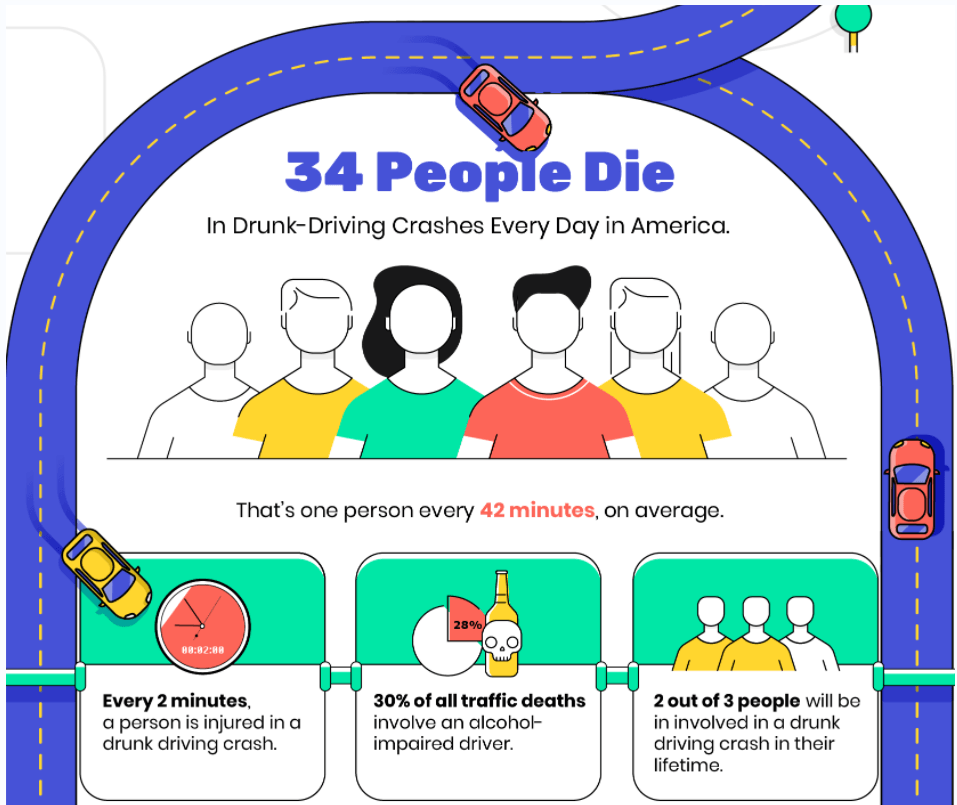
- Per NHTSA data, about 11,000 people died in alcohol-related crashes annually between 2014 and 2023.
- Each day, drunk driving is responsible for 34 deaths in the U.S. alone. That’s one person every 42 minutes.
- Someone is injured in a drunk driving crash every two minutes.
- 30% of all traffic deaths involved an alcohol-impaired driver.
- Two out of three people will be involved in a drunk driving crash in their lifetime.
As the NHTSA notes, drivers with a blood alcohol level (BAC) of 0.08 are four times more likely to have an accident than those who didn’t consume alcohol.
If your BAC is 0.15, you’re 12 times more likely to get involved in a crash than someone with no alcohol in the bloodstream. The risk is highest for young men who drive under the influence, as they’re more prone to reckless driving behaviors when intoxicated.
12,429 People Died in Drunk Driving Crashes in 2023
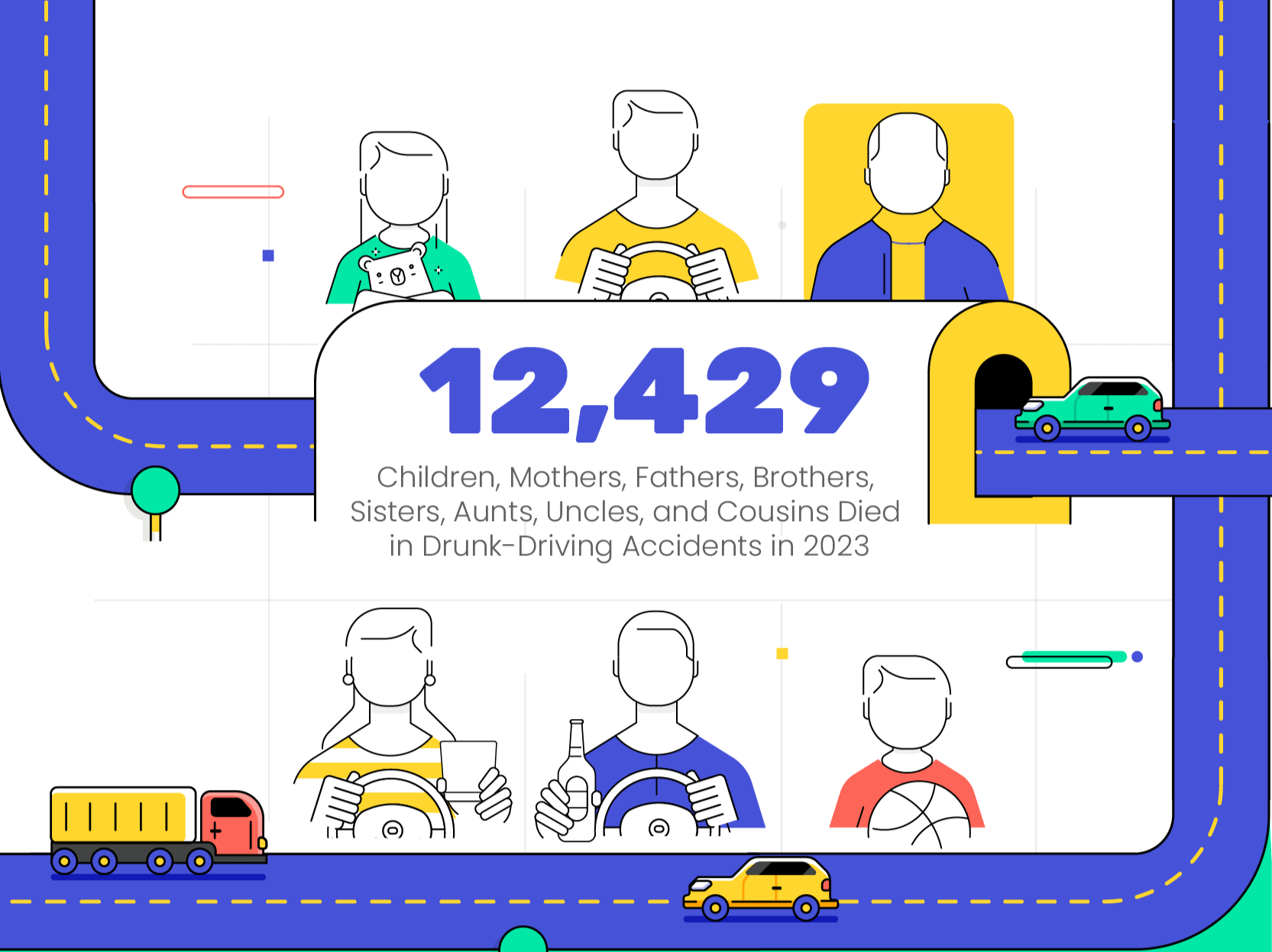
According to the NHTSA, drunk driving was responsible for 12,429 deaths in 2023 – an alarming figure, yet an improvement from the previous year. This marks an 8.1% decrease compared to 2022, when authorities reported 13,524 alcohol-related fatalities.
Read: California Car Crash Statistics
Drunk Drivers Make Our Roads Unsafe
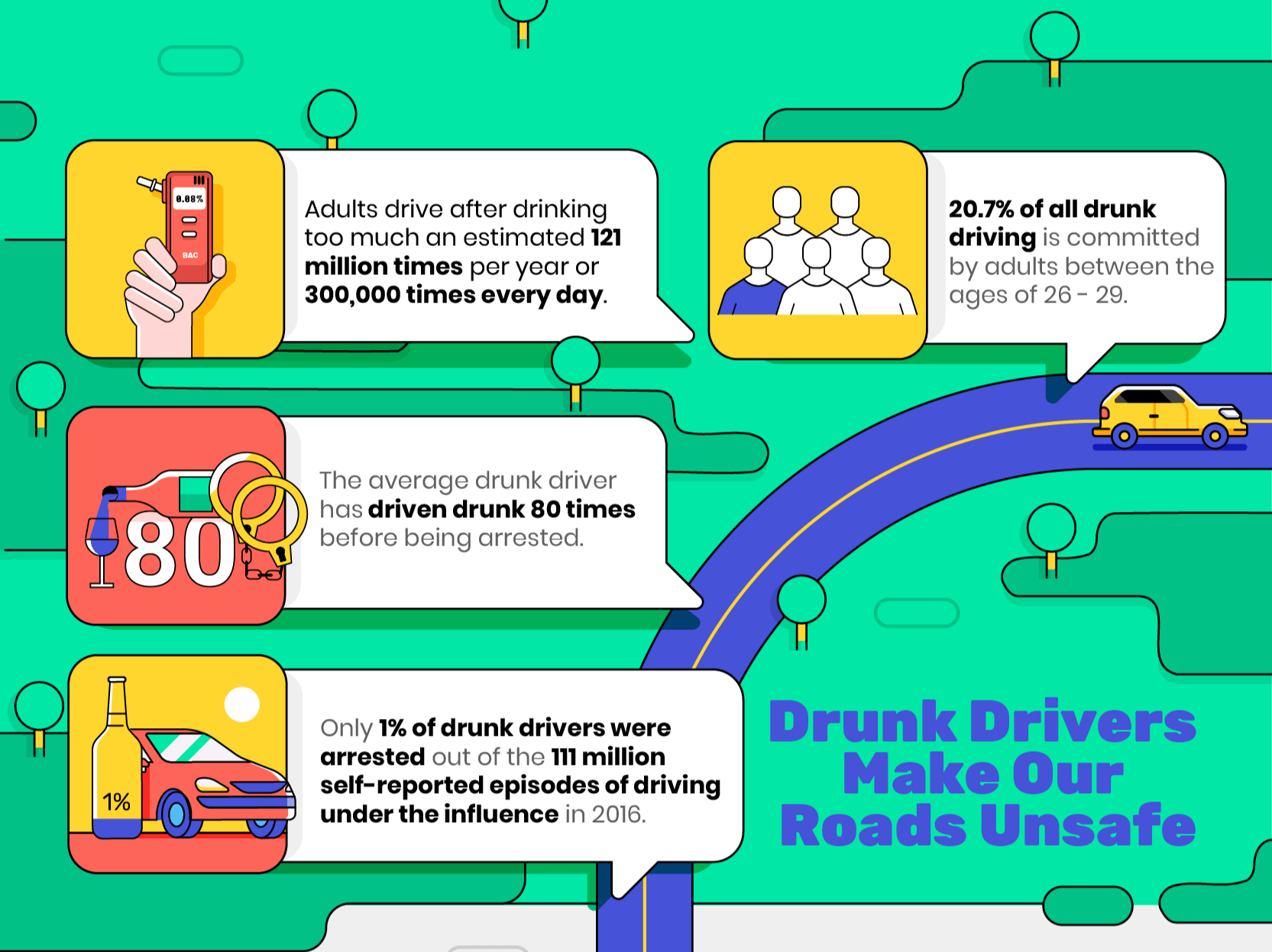
People drink and drive far more often than you might think – an estimated 121 million times per year, or 300,000 times every day. However, only 1% of drunk drivers are arrested.
In fact, the average drunk driver has gotten behind the wheel after drinking 80 times before they were arrested. Chances are, if you hit the road regularly, you will cross paths with an impaired driver at some point in your life.
Repeat Offenders Drive Up Danger
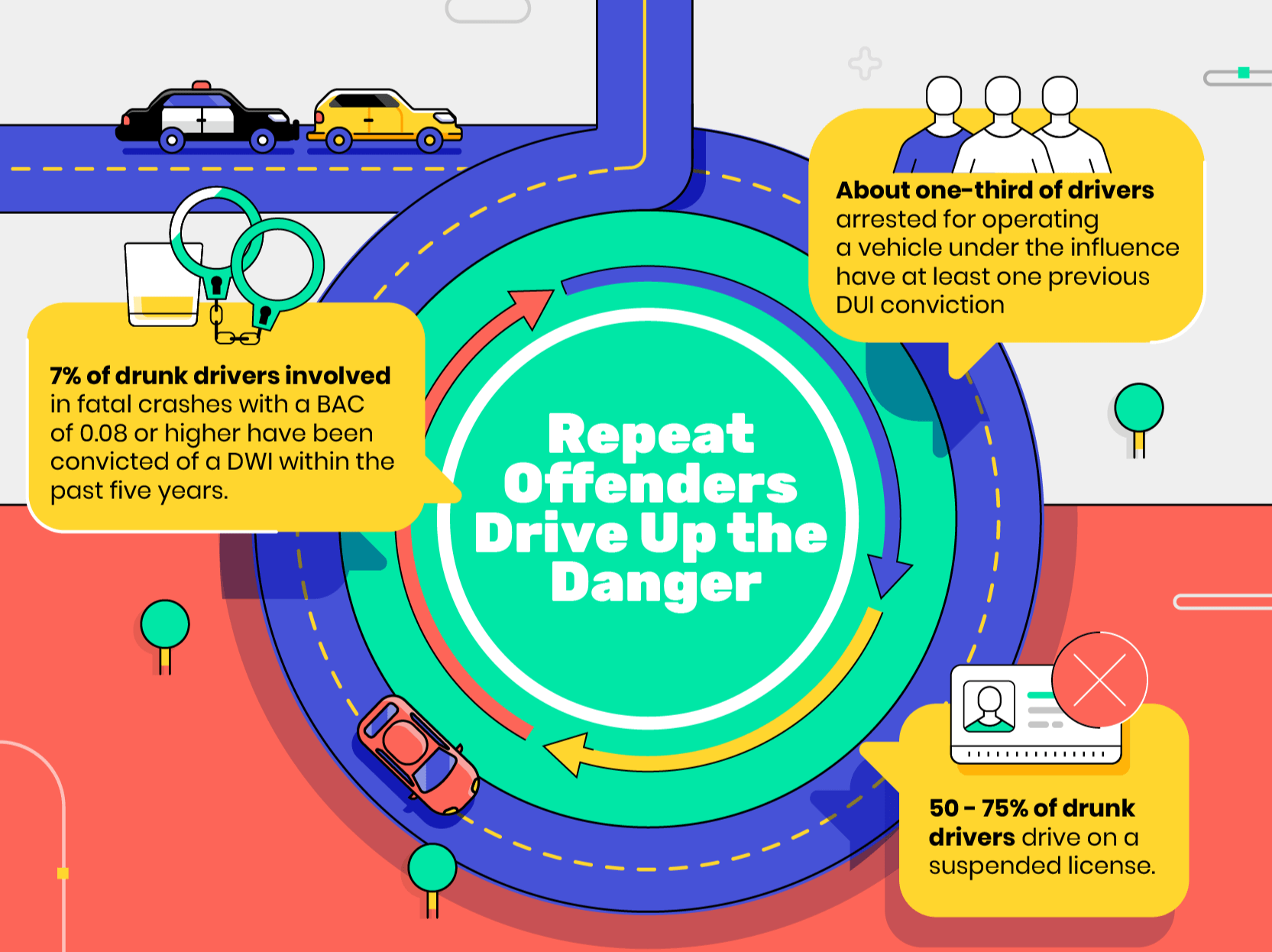
People who engage in risky behaviors while under the influence of alcohol once are more likely to do it again. Repeat offenders and individuals who are driving on an already-suspended license make up a large share of those convicted of drunk driving.
- One-third of people arrested for drunk driving have previous DUI convictions.
- 50-75% of those convicted of a DUI or DWI continue to drive while their license is suspended.
- 7% of drunk drivers involved in fatal crashes with a BAC of 0.08 or higher have been convicted of a DWI within the past five years.
We All Pay the Price for Poor Decisions
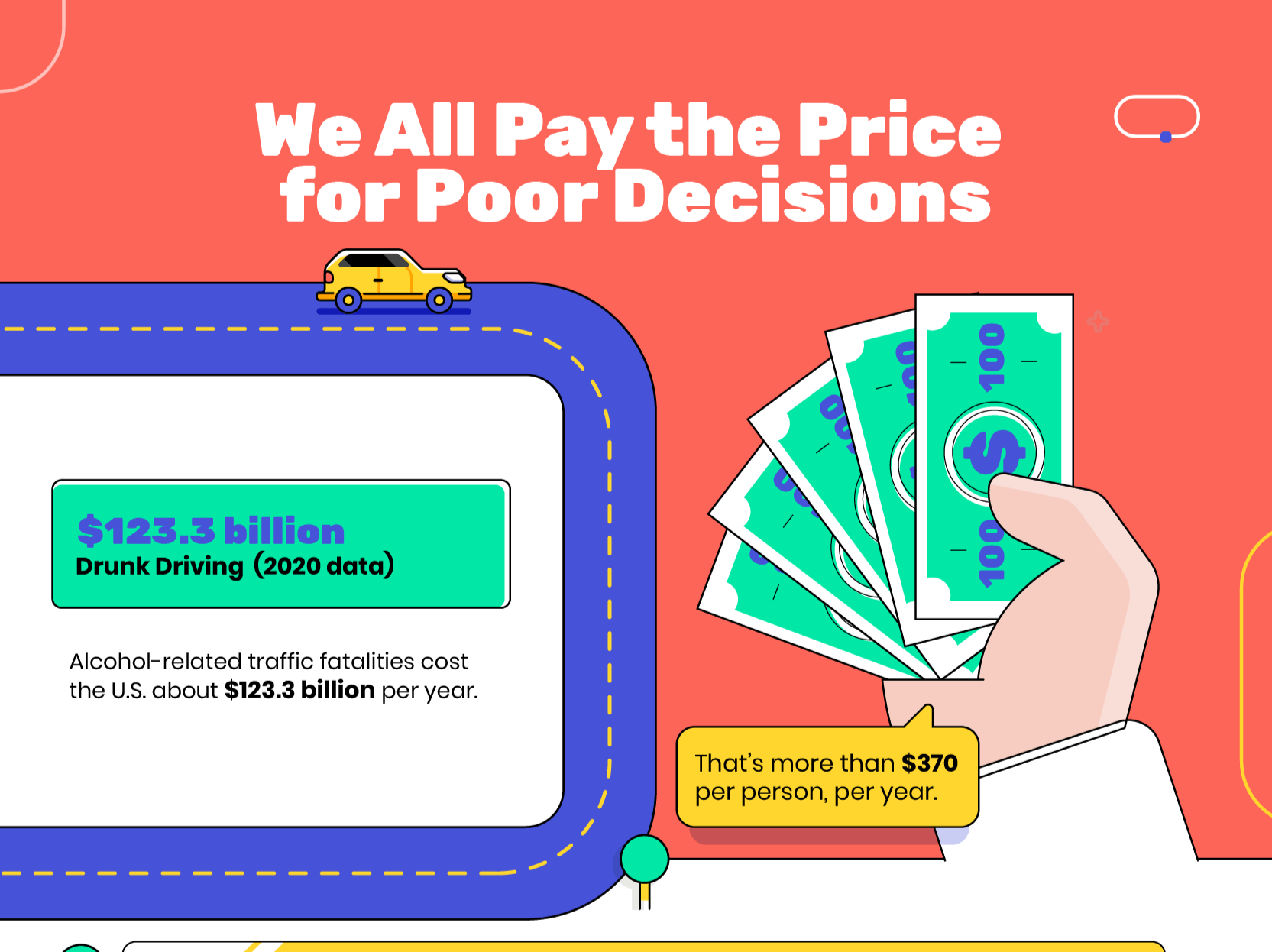
Fatal vehicle crashes cost the U.S. $123.3 billion yearly – that’s $370+ per person per day. However, no price can compare to the human cost of injuries and deaths caused by drunk driving.
Be a Responsible Driver
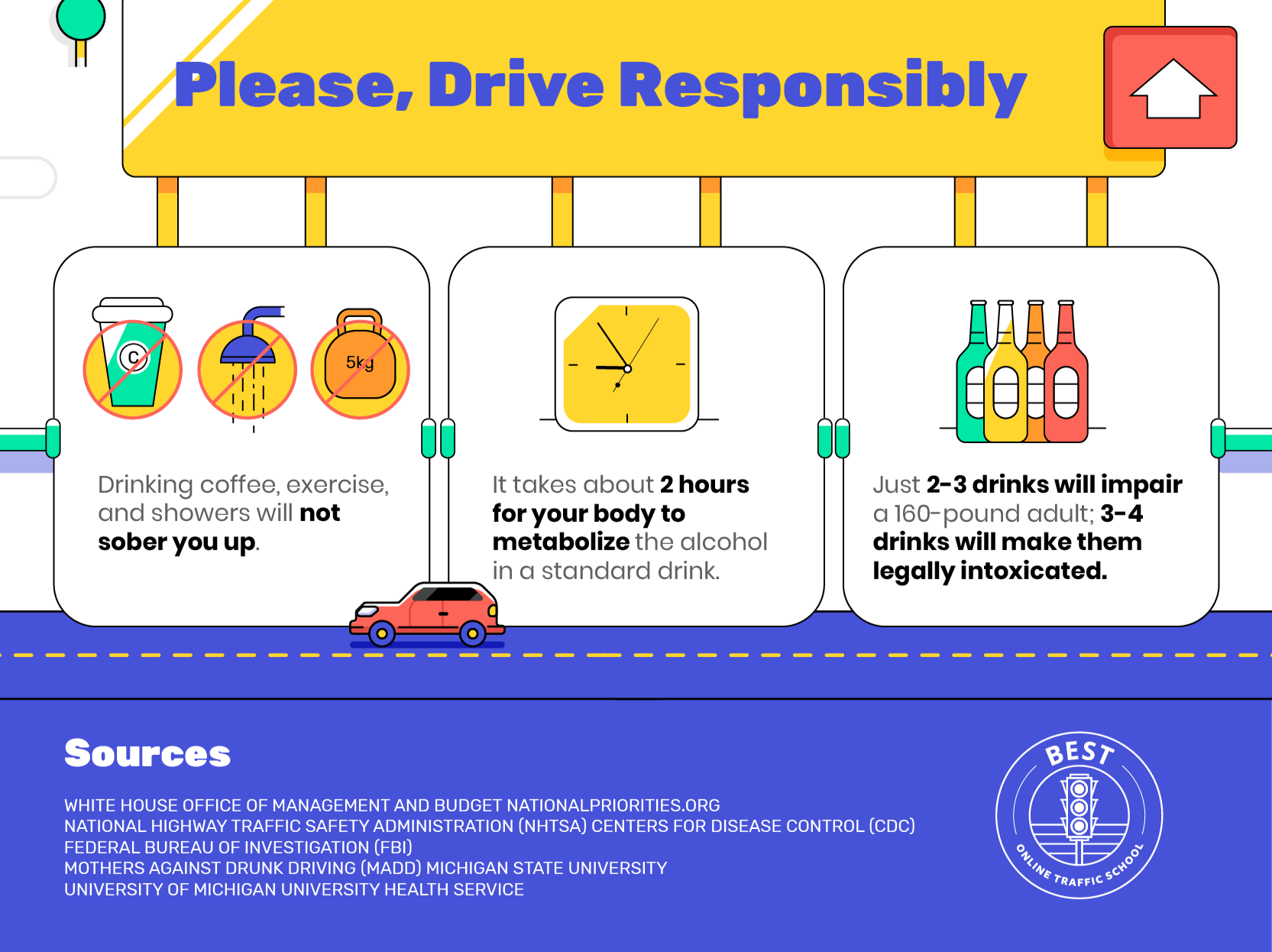
Contrary to popular belief, you cannot sober up by drinking coffee, showering, or exercising. Your body needs time to fully metabolize and process the alcohol consumed. That takes about 60 minutes if you only have one standard drink, such as:
- A 12-ounce beer (5% alcohol)
- A 5-ounce glass of wine (12% alcohol)
- 1 1/2 ounces of liquor (40% alcohol)
When it comes to driving, no amount of alcohol is safe. According to the University of Michigan, having just two drinks can raise your BAC to 0.02%, causing a decline in visual function, mood, judgment, and multitasking abilities.
At a BAC of 0.05%, you’ll have difficulty coordinating your movements, tracking objects in motion, or steering the car. Your reaction time will suffer, too.
As BAC increases, you’ll experience more pronounced side effects ranging from impaired self-control to short-term memory loss. These take more or less time to kick in, depending on:
- Sex: Women require less alcohol to become intoxicated than men.
- Body weight: The lower your weight, the faster you’ll feel the effects of alcohol.
- Speed of consumption: Drinking a large amount of alcohol in a short time causes a rapid spike in BAC levels.
- Food intake: Drinking on an empty stomach will make you drunk faster than if you eat beforehand.
- Medications: Antidepressants and other drugs can interact with alcohol, amplifying its side effects.
- Overall health: Certain health conditions, especially those affecting the liver and kidneys, can impact your body’s ability to process alcohol.
- What you drink: Two strong drinks may contain four or more servings of alcohol. Mixing them with tonic water or other carbonated beverages can speed up alcohol absorption and get you intoxicated faster.
Given these variables, the wisest choice is to abstain from drinking if you plan to drive. And if you choose to drink, have a backup plan that doesn’t involve getting behind the wheel.
Public Perception of Drunk Driving
One reason people get behind the wheel while impaired is that they underestimate their level of intoxication, assuming they’re fine to drive after having a drink or two.
According to a recent survey by American Addiction Centers, 23% of people drove within two hours of drinking in the previous month. The study also found that:
- 53% of respondents feel capable of driving after consuming alcohol.
- Nearly one-third said they drove after drinking because they didn’t feel intoxicated.
- 10% admitted to driving after drinking because their destination wasn’t “very far away.”
- 92% of study participants reported driving with passengers while under the influence at least once or twice over the past 30 days.
- 49.7% of people have ridden with a drunk driver at some point.
- 43% of drivers believe it’s safe to drink a cocktail before jumping behind the wheel.
- 32% assume they can drink two cocktails or liquor shots and still drive safely.
- 29% assume they can drink three or four beers before it becomes unsafe to drive.
- More than 24% of male drivers and 12% of female drivers confessed to driving while blackout drunk.
- 39% of respondents agreed that driving under the influence is “very likely” to cause a car crash. Another 42% said it’s “somewhat likely.”
Despite the risk, many people still choose to drive, indicating a disconnect between what people believe and how they behave behind the wheel.
Underage Drinking Statistics
A large share of drunk driving fatalities involve teenagers. In a 2023 survey, 12.6 million people aged 12 to 20 reported having consumed alcohol at least once in their lifetime.
- Per NHTSA data, one-third of crash fatalities among 15- to 20-year-olds in 2023 involved a BAC of at least 0.01.
- About 25% of teen car accidents involve an underage driver who has been drinking.
- Underage teenagers who drink alcohol or ride with impaired drivers are more likely to drive while intoxicated.
- Although teen drivers are less likely to drink and drive than adults, their crash risk is higher even at low or moderate BAC levels.
- Nearly 70% of drivers aged 15 to 20 who were killed in alcohol-related crashes in 2022 weren’t wearing a seat belt.
How Alcohol Impacts Driving Abilities
Alcohol, even in small amounts, causes physical and psychological changes that can impact your ability to drive safely. According to the World Health Organization, the risk of a crash increases significantly once your BAC reaches 0.04.
Not only does alcohol consumption reduce inhibition, but it also contributes to high-risk behaviors like drug use and distracted driving. Below are just some of its adverse effects:
1. Slower Reaction Times
Drinking slows down your reaction time, affecting your ability to make quick driving maneuvers like slowing down, stopping, or steering in response to sudden hazards.
Having a BAC of 0.08 decreases reaction time by 120 milliseconds. That may not seem like much, but it can make the difference between life and death when you’re behind the wheel.
2. Lack of Coordination
Drinking affects your motor skills, including your coordination. When drunk, most people struggle to stand up straight or walk in a straight line. Behind the wheel, where safe driving means coordinating hand, eye, head, and leg movements, losing coordination can quickly become deadly.
3. Reduced Concentration
Driving a vehicle requires focusing on your car, the road ahead of you, any other vehicles around you, and your surroundings.
Alcohol inhibits concentration, which means you may become distracted while driving or fail to see or hear dangerous hazards on the road.
4. Vision Problems
It’s common for people to have blurred vision and uncontrolled eye movements while under the influence of alcohol. This is especially dangerous while driving, when you need to see where you’re going and judge visual cues that tell you things like speed and distance between objects.
5. Impaired Judgment
Alcohol impairs your judgment and lowers your inhibitions. That means that after drinking, you’re more likely to make potentially dangerous choices than you would if you were sober.
For example, you may find yourself texting and driving while under the influence. You could also engage in risky behaviors like speeding, ignoring traffic signals, or making unsafe turns, which can further increase the odds of a crash.
6. Changes in Color Perception
Alcohol use can affect your ability to distinguish colors. As a result, you may not react to traffic signs and signals, which can easily lead to an accident.
7. Overconfidence
Alcoholic beverages impact the brain areas responsible for judgment. This can reduce your inhibitions and make you feel more confident. These factors can contribute to dangerous behaviors you wouldn’t otherwise engage in.
Even at a BAC of 0.07, where driving ability is noticeably reduced, many drivers don’t realize they’re impaired. This false sense of confidence makes alcohol consumption particularly dangerous, as it masks poor decision-making when it matters most.
Consequences of Drinking and Driving
Drinking and driving can impact nearly every aspect of your life, especially if something goes wrong. This behavior has financial, legal, and societal implications, including but not limited to:
1. Higher Insurance Rates
Getting a DUI or DWI conviction can cause your auto insurance rates to skyrocket. According to Bankrate, a single DUI charge can raise your premiums by up to 100%, depending on the insurance provider.
2. Legal Implications
Being convicted of DUI or DWI can mean jail time or steep fines. Consequences vary by state, but they can be life-altering, particularly for repeat offenders.
3. Driver’s License Suspension
In many states, a DUI or DWI conviction results in automatic license suspension for six months or longer. If you get multiple convictions, your license could be permanently revoked.
4. Injuries and Deaths
The worst potential consequence of drinking and driving is the human cost. Drunk driving crashes cause thousands of injuries and deaths each year. If you get behind the wheel after drinking, you could injure or kill yourself or others.
Can You Attend Traffic School for a DUI?
Unfortunately, no. In most states, drinking and driving is classified as a misdemeanor, and, in some cases, it can be elevated to a felony. Regardless, the charge automatically disqualifies you from traffic school.
However, you can go to traffic school after being charged with texting and driving, tailgating, running a red light, and other infractions. Upon course completion, the court will mask one point on your license, preventing your insurance premiums from going up.
Our California traffic school course is 100% online, and you can finish it in just two or three hours. Plus, you can study from any device and take breaks as needed without losing your progress.
At Best Online Traffic School, we go the extra mile to ensure a stress-free learning experience. That’s why we offer:
✅ Free English, Spanish, and Chinese read-along
✅ Unlimited course retakes
✅ Unlimited exam attempts
✅ Same-day certificate submission to the court and DMV
✅ Instant certificate of completion
✅ 24/7 live chat support
The best part? You don’t have to pay anything until you pass.
So, you can start the course, go through all the modules, take the final exam, and pay our flat fee of only $27.99 after getting a passing score.
